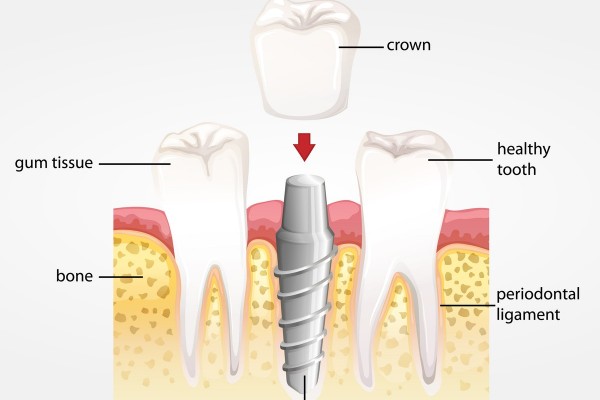Anyone who is missing a tooth might be a good candidate for dental implant surgery. Dental implants are one of the best possible solutions for a missing tooth, because they provide a permanent replacement for it. The patient with a dental implant is able to experience normal dental function, and it has a very natural feeling to it, so that you don’t even notice it.
There are three major elements involved with dental implant surgery: the implant itself, the restoration, and the abutment. Anyone who would like to understand how dental implants work should gain an understanding of how these elements work together. When everything is done correctly, these three aspects of a dental implant will work very well together to restore natural dental function.
The Dental Implant Itself
A dental implant should not be thought of as a replacement tooth, but instead it provides a foundation for which a restoration can be attached later on. In actuality, dental implants themselves are small titanium posts which are surgically implemented through the gums and into the jaw bone. Some patients may require more than one implant in order to secure the restoration which will be necessary.
However many dental implants are needed, after they are installed it will be necessary for a patient to wait several months for osseointegration to take place. Osseointegration is a natural process during which a patient’s jawbone goes through healing in the area around an implant. This creates a very powerful bond which approximates the natural bond between tooth roots and the jaw bone. Once this osseointegration has completed, the next stage of the dental implant surgery can take place.
The Abutment
Once the site of the dental implant has undergone sufficient healing, it will be possible to emplace the abutment. The abutment consists of an attachment which joins the dental implant to the restoration. Sometimes it will be possible for the abutment to be installed at the same time as the dental implant. Whether or not the abutment is installed simultaneously with the dental implant, it will still be necessary to wait for healing to occur. In most cases, it will take between four and 12 months for sufficient healing to take place before the restoration can be implemented, to complete dental implant surgery.
The Restoration
There are a variety of restoration types which can be implemented along with your dental implant. The specific kind of restoration implemented will generally depend on the patient’s needs. In particular, the number of missing teeth will have a major impact on the kind of restoration which is installed. When the bone is completely healed in the area surrounding the implant, and the dentist has installed the abutment, it will be possible to install one of three restoration types.
The first of these is a dental crown, which can be paired with a dental implant for the replacement of either a single tooth or possibly two teeth. The next restoration is an implant-supported bridge, and this is generally used when multiple teeth are missing, but where dentures are not really needed. An implant-supported bridge works very much like a traditional bridge, except that it doesn’t attach to the surrounding teeth. Instead, it is connected to the dental implant which has been installed previously.
The last kind of restoration is known as an implant-supported denture, and this is also used when multiple teeth are missing. An implant-supported denture generally requires between three and five dental implants, so that it can properly anchor the restoration when it’s installed. This will allow denture wearers to eat all of their favorite foods, without the embarrassment and inconvenience of having their dentures slide around inside the mouth.
Are Dental Implants Right For You?
If you are missing one or more teeth, a dental implant could provide a solution to your situation. The best way to determine this is to set up a consultation with your dentist, and go through a thorough examination of your mouth, specifically in the area the missing teeth. If you currently have periodontal disease or some other oral issues, you may not be a good candidate for dental implant surgery until these issues have been cleared up. Your dentist will be able to tell you whether or not you are good candidate for the procedure.
Dental Implants at the Good Samaritan Dental Implant Institute
Florida residents are fortunate indeed that they have one of the foremost facilities in the country for dental implant surgery. At the Good Samaritan Dental Implant Institute in West Palm Beach, FL, a team of experts headed by Dr. Andrew Slavin provides the most experience for dental implant patients. Contact the Institute with any inquiries you may have, or to set up a consultation with Dr. Slavin.

